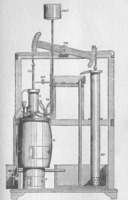All of the images here are in the public domain in the USA, with sources as indicated.
Often the originals are too large to present online. Click (or right-click to download) on each image for a larger (if not as large as possible) version.
The images which serve as links to other documents on this site are described on the "About the Images" pages for those linked documents.
From P.N.Hasluck. The Clock Jobber's Handybook. (London: Crosby Lockwood & Son, 1914.) Scanned by the author from the original.
From Avery, Elroy M. School Physics: A New Text-Book for High Schools and Academies . NY: Sheldon and Company, 1895. p. 127. Scanned by the author from the original.
For some reason, this drawing reminds me of David Macaulay's wonderful cartoon "Early Work on the Grand Canyon," in his book Great Moments in Architecture.
From Phillips, John Arthur. A Manual of Metallurgy. London: Richard Griffin and Company, 1859, p. 478. Scanned by the author from the original.
[click image to view larger]
This is a crucible made of welded iron plate,
used in the assay of lead ore.
(However, the same cut is used in the Griffin catalog bound
at the end of the book to illustrate apparatus for sale
for the assay of gold and silver.)
See the "About the Images" document for Metalsmithing.
From Jamieson, Andrew. A Text-Book on Steam and Steam Engines: Specially Arranged for the Use of Science and Art, City and Guilds of London Institute, and Other Engineering Students . London: Charles Griffin and Company, 1886. Scanned by the author from the original.
This is a represents "Watt's Model [steam engine] in Glasgow University," a model of a Newcomen-style atmospheric steam engine which Watt was called upon to repair in the 1760s and the analysis of which played an important role in his work on steam engines.







